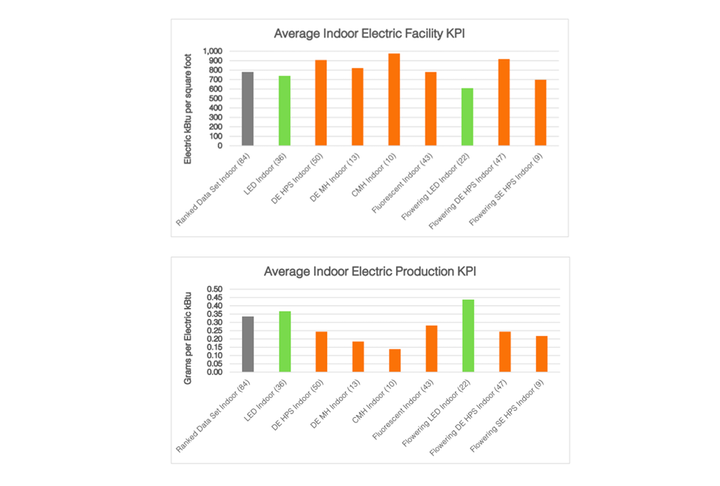RII evaluates the energy efficiency performance of 84 indoor cultivation facilities within its Cannabis PowerScore data set
Portland, Ore. (Oct. 23, 2020) — The non-profit Resource Innovation Institute (RII) evaluated the energy use of 84 indoor cannabis cultivation facilities and found that facilities using LED lighting were more energy efficient than facilities without LED lighting on two key measures.
The findings were drawn from RII’s Cannabis PowerScore, a voluntary resource benchmarking platform that gathers confidential facility information about energy use, production output and cultivation methods, and provides operators with a competitive performance ranking relative to the aggregate Ranked Data Set. The PowerScore Ranked Data Set is analyzed to inform governments, utilities and industry leaders on how – and how much – energy and water is being used across various cultivation environments.
The lighting study assessed indoor facilities that lit their canopies across various stages of growth and grouped those facilities based on prevalence of common horticultural lighting solutions, from High Pressure Sodium (HPS) to Ceramic Metal Halide (CMH) to fluorescent (T5 or T8) to Light Emitting Diode (LED).
The two groupings of facilities that performed best both contained LED lighting in at least one phase of their operations. Facilities that use LED lighting in the flowering stage were the top performers.
Key Performance Indicators assessed were Electric Facility Efficiency and Electric Production Efficiency. Electric Facility Efficiency is similar to area-based Energy Use Intensity (EUI) often used by architects, engineers, and utilities to evaluate commercial and residential buildings occupied by humans; Electric Facility Efficiency uses units of electricity measured in kiloBtu (kBtu) per square foot of flowering canopy to normalize EUI for cannabis cultivation facilities, buildings occupied by plants. Electric Production Efficiency is similar to production-based metrics typically used in industrial settings where efficient output of product is the objective; Electric Production Efficiency uses grams of cannabis flower produced in grams (g) per unit of electricity measured in kBtu. Electricity is often measured in kilowatt-hours (kWh), and RII converts from kWh to kBtu. kBtu is used as a standardized unit of energy to enable comparison across all fuel types and conversion to equivalent carbon emissions (CO2eq).
The graphs below summarize Electric Facility Efficiency (the lower, the better) and Electric Production Efficiency (the higher, the better). The grey bar shows the average performance of the complete indoor Ranked Data Set; the green bars denote the facilities using LED lighting systems, the orange bars denote facilities using other kinds of lighting systems. The numbers in parentheses next to each group’s label designates the number of records in the group within the dataset of indoor facilities.

The most significant finding is that indoor operations using LED lighting for flowering growth stages achieve 34% better Average Electric Facility Efficiencies and 80% better Average Electric Production Efficiencies than indoor facilities using double-ended (DE) HPS lighting for the flowering growth stage.
“These findings demonstrate the ability of LED technology to drive energy and production efficiency in horticultural operations,” said Derek Smith, RII’s Executive Director. “It should be noted that the range of performance across the facilities we studied is broad, meaning there is a large variability among users. We know cultivator education and training is essential to achievement of energy savings, and there’s a lot more we don’t know. More research is critical to establishing standards that result in greater energy efficiency and productivity, improved product quality and lower environmental impact.”
More findings from PowerScore are on the horizon as cultivators, their supply chain advisors, utilities, efficiency program administrators, and governments leverage the platform beyond voluntary benchmarking. Since July, RII has been helping Massachusetts cultivators gain access to best practices on resource efficiency and use PowerScore Comply and Benchmark service to easily meet the state’s energy and water reporting requirements and receive benchmark reports ranking them in energy, water, and waste performance against the Ranked Data Set.
Additional RII research is also on the horizon. As more data is gathered, RII will explore how a variety of lighting strategies are affecting energy use in greenhouses, where natural sunlight is supplemented with electric lighting. As the PowerScore Ranked Data Set grows, further insights will reveal how whole-building energy use – including fossil fuel consumption and renewable energy generation – is impacted by facility size, location and climate, cultivars, and other building technologies in operation.
Meanwhile, RII advocates for governments and utilities to consider the following as they develop policies and programs promoting efficiency:
- Cultivation operations are complex environments where the interactive effects of HVAC, dehumidification and lighting technologies influence operational efficacy and the biological processes that drive plant growth and facility productivity
- Understanding the most influential factors impacting performance is critical to refine best practices and achieve further energy savings
- More data is needed to inform the market, and energy reporting, benchmarking, and research into optimizing interactive effects should be prioritized
- Utilities and efficiency programs can access many resource benefits and help customers by further investigating and supporting whole-building efficiency strategies
- Cultivator, supply chain and utility training on resource efficiency best practices should be paired with incentives on efficient technologies
For more information or to schedule an interview, please contact Shawna Seldon McGregor at 917-971-7852 or shawna@themaverickpr.com.
About Resource Innovation Institute: Advancing Resource Efficiency to Cultivate a Better Agricultural Future
Resource Innovation Institute (RII) is a non-profit organization whose mission is to advance resource efficiency to cultivate a better agricultural future. Founded in 2016 to address the resource impacts of cannabis cultivation, RII is extending its services to other energy-intensive horticultural sectors. Its PowerScore benchmarking platform represents the world’s largest dataset on indoor agriculture energy use. RII’s Technical Advisory Council, which includes a Policy Working Group and a Utility Working Group, is the leading multi-disciplinary body assessing the environmental impacts and best practices associated with cultivation resource issues. RII’s Board of Directors includes the American Council for an Energy Efficient Economy (ACEEE) and a former board member of the US Green Building Council. RII is funded by utilities, foundations, governments and industry leaders. Visit our website at ResourceInnovation.org. Follow us on LinkedIn, Facebook, Twitter and Instagram.
# # #
Cross-posted on Cannabis Business Times, October 29, 2020.



